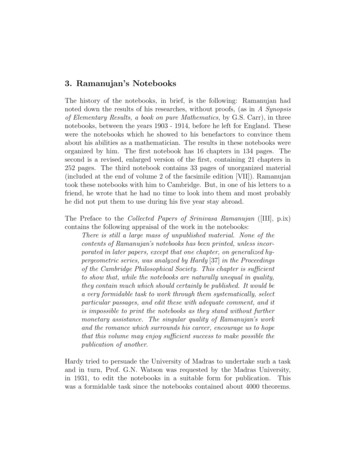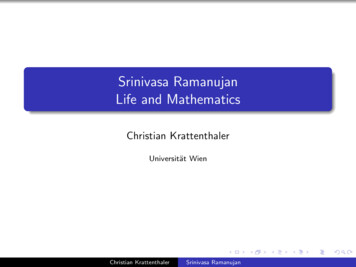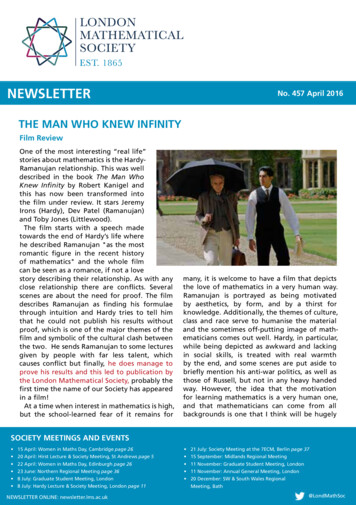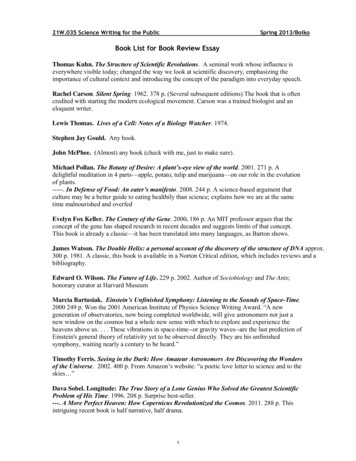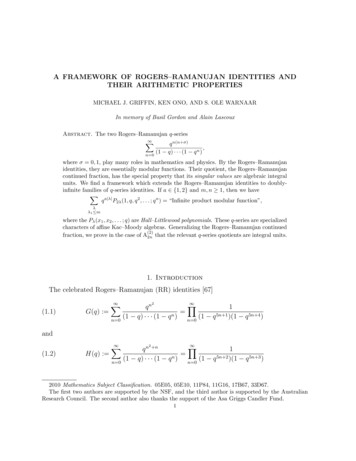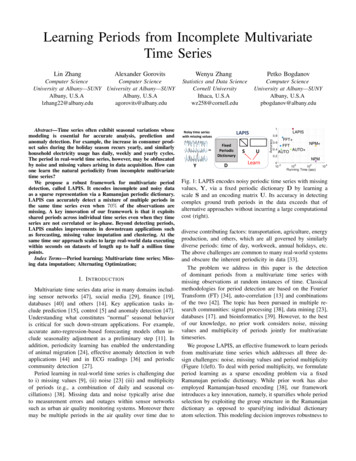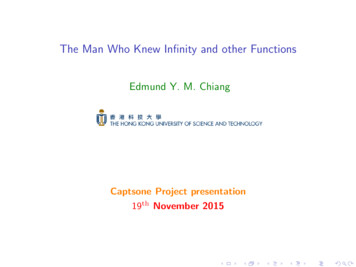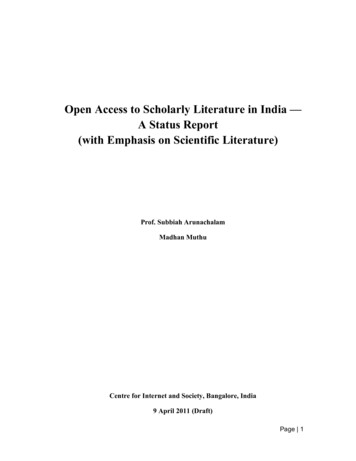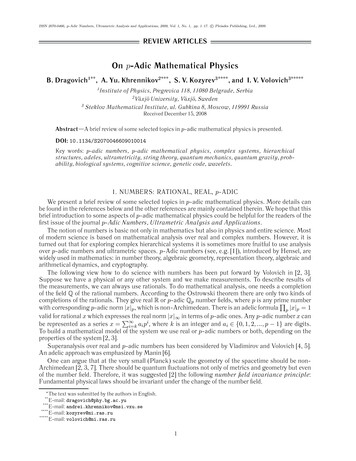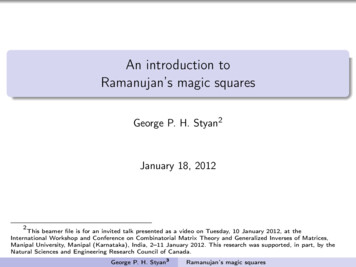
Transcription
An introduction toRamanujan’s magic squaresGeorge P. H. Styan2January 18, 20122This beamer file is for an invited talk presented as a video on Tuesday, 10 January 2012, at theInternational Workshop and Conference on Combinatorial Matrix Theory and Generalized Inverses of Matrices,Manipal University, Manipal (Karnataka), India, 2–11 January 2012. This research was supported, in part, by theNatural Sciences and Engineering Research Council of Canada.George P. H. Styan3Ramanujan’s magic squares
Acknowledgements: January 18, 2012B3-01aThis beamer file is for an invited talk presented on Tuesday, 10 January 2012, atthe International Workshop and Conference on Combinatorial Matrix Theory andGeneralized Inverses of Matrices, Manipal University, Manipal (Karnataka), India,2–11 January 2012.I am very grateful to Professor Prasad and the Workshop participants whoreminded me of Ramanujan’s work on magic squares and to Dr. B. Chaluvarajufor drawing our attention to “Bangalore University’s old collections in the librarywhich deal with Yantras and magic squares.”In addition, many thanks go to Pavel Chebotarev and Ka Lok Chu for their help.This research was supported, in part, by the Natural Sciences and EngineeringResearch Council of Canada.George P. H. Styan4Ramanujan’s magic squares
Srinivasa Aiyangar Ramanujan (1887–1920)Srinivasa Aiyangar Ramanujan (1887–1920)was born in Erode and lived in Kumbakonam(both then in Madras Presidency, both now in Tamil Nadu),and died in Chetput (Madras, now Chennai).George P. H. Styan5Ramanujan’s magic squaresB3-01b
Erode, Kumbakonam, ChennaiGeorge P. H. Styan6B3-02aRamanujan’s magic squares
Kumbakonam (near Thanjavur)B3-02bRamanujan lived most of his life in Kumbakonam, an ancient capital of theChola Empire. The dozen or so major temples dating from this period madeKumbakonam a magnet to pilgrims from throughout South India.Raja Raja Chola I, popularly known as Raja Raja the Great,ruled the Chola Empire between 985 and 1014 CE.George P. H. Styan7Ramanujan’s magic squares
22 December National Mathematics DayB3-03Srinivasa Aiyangar Ramanujan was born on 22 December 1887,and on 22 December 1962 and on 22 December 2011,India Post issued a postage stamp in his honour.On 22 December 2011, Prime Minister Dr. Manmohan Singh in Chennaideclared 22 December as National Mathematics Day, and declared2012 as National Mathematical Year. [The Hindu, 27 December 2011.]George P. H. Styan8Ramanujan’s magic squares
Gauss, Euler, Cauchy, Newton, and ArchimedesRamanujan’s talent was said9 by the English mathematicianGodfrey Harold “G.H.” Hardy (1877–1947)to be in the same league as that ofGauss, Euler, Cauchy, Newton, and Archimedes.9“Srinivasa Ramanujan”, Wikipedia, 7 January 2012, p. 1.George P. H. Styan10Ramanujan’s magic squaresB3-04
Trinity College, Cambridge, and G. H. HardyB3-05From 1914–1919 Ramanujan workedwith G. H. Hardy at Trinity College, Cambridge11 .G H Hardy11Photographs (left panel: Ramanujan, centre) from “Srinivasa Ramanujan”, Wikipedia, 7 January 2012, p. 8.George P. H. Styan12Ramanujan’s magic squares
Berndt 1985B3-06Ramanujan’s work on magic squaresis presented, in some detail, inChapter 1 (pp. 16–24) ofRamanujan’s Notebooks, Part I, byBruce C. Berndt (Springer 1985)“The origin of Chapter 1probably is found inRamanujan’s early school daysand is therefore much earlier thanthe remainder of the notebooks.”George P. H. Styan13Ramanujan’s magic squares
Tata Institute 1957B3-07Ramanujan’s work on magic squares was also presented,photographed from its original form, inNotebooks of Srinivasa Ramanujan,Volume I, Notebook 1, and Volume II, Notebook 2,pub. Tata Institute of Fundamental Research, Bombay, 1957.George P. H. Styan14Ramanujan’s magic squares
Ramanujan’s 3 3 magic matrixB3-08In Berndt 1985, Corollary 1, p. 17, we find:In a 3 3 magic square,the elements in themiddle row, middle column,and each [main] diagonalare in arithmetic progression.George P. H. Styan15Ramanujan’s magic squares
Ramanujan’s 3 3 magic matrix R3B3-09And so we have the general form for a 3 3 magic matrix h u R3 h u vh v 1 1 1h u vh v h u v hE3 uU3 v V3hh u v h u1 1 u 1111 h 1 1 100 1 1 11 0 v 1 11 10.George P. H. Styan160Ramanujan’s magic squares 1 .0
Ramanujan’s 4 4 magic matrix R4B3-10Berndt (op. cit., p. 21) presentsa pd sc qb r c r R4 b s d qb qa sc pd ra rb p d p a q c s adcbpsqr c b dbaqscdprab d r a s qcrp p ,q s the sum of two orthogonal Latin squares (Graeco-Latin square).George P. H. Styan17Ramanujan’s magic squares
Ramanujan’s 5 5 magic squareB3-11Ramanujan (Tata Institute 1957, Volume II, Notebook 2, p. 12 original p. 8)gives this 5 5 magic square, which is also thesum of two orthogonal Latin squares (Graeco-Latin square).George P. H. Styan18Ramanujan’s magic squares
Ramanujan’s 7 7 and 8 8 magic squaresB3-12Berndt (op. cit.) reports two 7 7 (p. 24) and two 8 8 (p. 22)magic squares (but apparently no 6 6) by Ramanujan, including R7 4132340515324614243861630478223972131 , 48 R8 0274720214239282934and says that R8 is “constructed from four 4 4 magic squares”.We find that R8 may be constructed from two 4 4 magic squares.George P. H. Styan19Ramanujan’s magic squares ,
Ramanujan’s 8 8 magic matrix R8B3-13The classic fully-magic Nasik (pandiagonal) matrix with magic sum m(R8 ) 260 R8 0274720214239282934 (11)R8 04 04 0404(11)(21)(12)04 (12)R8 04 (21)04R8 04 040404 04(22)R8 ,(22)where R8 , R8 , R8 , R8 are 4 4 fully-magic Nasik (pandiagonal) matriceseach with magic sum 130 21 m(R8 ).(11)(12)(21)(22)Moreover, the magic matrices R8 , R8 , R8 , R8 are interchangeable and sothere are 4! 24 fully-magic Nasik (pandiagonal) 8 8 matrices like R8 .George P. H. Styan20Ramanujan’s magic squares
(11)Ramanujan’s 4 4 magic submatrices R8(12), R8(21), R8(22)B3-14a, R8Furthermore,(12)R8(11) R8(21) 8X,R8(11) R8(22) 16X,R8where the fully-magic Nasik (pandiagonal) 4 4 matrices 1 1 1 62 59 8 (11)R860 6726157643634558 ,X (11) R8 11 111 11 1 11 111 1 24X, ,(11)with magic sums m(R8 ) 12 m(R8 ) 130 and m(X) 0. And so we may writeRamanujan’s 8 8 magic matrix as the sum of two Kronecker products: 1 62 59 8 9 54 51 16 R8 282934George P. H. Styan21 1 1 11(11) R8 0 8 2Ramanujan’s magic squares 13 X.
Ramanujan’s magic matrix R8 and the Agrippa magic matrix A4B3-14bThe 4 4 magic-basis matrix B4 311 31 1 11 111 13 1 13 DX,where D 3000010000100003 ,while X 1 1 11 111 11 1 11 111 1 is the doubly-balanced 4 4 magic matrix used in our “two-Kronecker-productsconstruction” of Ramanujan’s 8 8 magic matrix R8 . The 4 4 Agrippa–Cardanomagic matrix 4 14 15 1 97612A4 21 4B4 B04 (42 1)E4 5 11 10 8 .16George P. H. Styan2223Ramanujan’s magic squares13
The Man Who Knew InfinityB3-15For a“model of the biographer’s art”we recommendThe Man who Knew Infinity:A Life of the Genius Ramanujan,by Robert Kanigel,pub. Charles Scribner’s Sons 1991;Washington Square Press 1992George P. H. Styan23Ramanujan’s magic squares
likely to remain the canonicalReviewreference book for all aspects of"An extraordinary compellingbiography, richly textured withsocial, psychological, personal,and mathematical details.Awarm, romantic tale that wouldbe beyond the scope ofimagination were it not, after all,true. [Other] reviewers justlyOriginal Scribners hardcover edition, 1991praise this book as one of the bestscientific biographies everGeorgelifeP. H.Styan24magicsquares-- American Mathematicalascinating account of Ramanujan'swhichreads Ramanujan’slike awritten."Original Washington Square-- From the dustjacket of the Scribner's hardcover edition,1991seen." -- John Gribbin, author of In Search of Schrodinger's Cat"Enthralling.One of the best scientific biographies I've ever"Perspicacious, inforimaginative, [The MaInfinity] is to my mimathematical biograever read.[It]is not jbiography of Ramangenius born in a ho'life and works,' parttwo Works. It is a seintimate portrait ofthe human being, wmathematics.You dhave any sympathymathematics to read"Even a complete innumerate canenjoy Mr. Kanigel's richly detailedbook.Kanigel desmontratesconsiderable psychologicalacumen in his portait of the twocentral figures.A thoroughlycaptivating book." -- New YorkTimes Book Review"This is the best biography of a mathematician, in fact of any1993scientist, that I have ever read." -- Bruce Berndt, Universityof IllinoisOriginal Washington SquarePress paperback edition, 1992"An extraordinary cbiography, richly texsocial, psychological,and mathematical dwarm, romantic talebe beyond the scopeimagination were ittrue. [Other] reviewpraise this book as oscientific biographiewritten." -- AmericanMonthly"Even a complete inenjoy Mr. Kanigel's rbook.Kanigel desmconsiderable psycholacumen in his portaicentral figures.A thcaptivating book." -Times Book Review1993German edition, Verlag Vieweg,"A fascinating account of Ramanujan's life which reads like asad romantic novel." -- Julius Axelrod, Nobel laureateOriginal Scribners hardcover edition, 1991triumph is in the tellwonderful human stew"Poignant and absorbing." --his brief life for many years tocome.[I] can recommend itwholeheartedly to bothmathematicians and to generalreaders." -- The MathematicalGazettependent (U.K.), Times Literary Supplement (U.K.), Farern EconomicScientist, Isis, SewaneeThe ManReview,Who AmericanKnew Infinity"A superbly craftedB3-16biography.[Kanigel's] exceptionaltriumph is in the telling of thiswonderful human story." -- Science
The Man Who Knew InfinityB3-171Scribner’s hardcover, 19912U.K. hardcover, Scribner’s, 19913Washington Square Press paperback, 19924U.K. paperback, Abacus, 19925Indian edition, Rupa, 19926German edition, Vieweg Verlag, 19937Cassette book, National Library for the Blind, 19938Japanese edition, Kousakusha, 19949Korean edition, Science Books, 200010Chinese editions, Shanghai Scientific, 2002, 200811Italian edition, Rizzoli, 200312Thai edition, Matichon, 200713Audio edition, Blackstone Audio, 200714Greek edition, Travlos, 2008George P. H. Styan25Ramanujan’s magic squares
German edition, Verlag Vieweg,1993George P. H. Styan26Ramanujan’s magic squaresWashington Square Presspaperback, 1992mathematics to read The Man WhoKnew Infinity with pleasure; but bythe time you have finished it,some of Ramanujan's love of hissubject will probably have rubbedoff on you, and you will havebegun to appreciate the hypnoticfascination that it exerts uponthose who make it their life'swork." -- New York Review of Books12-01-07 4:17 PMItalian edition, L'uomo che vide l'infinito, Rizzoli,2003matheKnewthe timsomesubjecoff onbegunfascinthosework.Page 4 of 4"Poignant and absorbing." --Washpaperi 58016.htmItalian edition, L'uomo che vide l'infinito, Rizzoli,2003TY: A Life of the Genius Ramanujan - Robert KanigelOriginal Washington SquarePress paperback edition, 1992German edition, Verlag Vieweg,1993Der das Unendliche kannte; L’uomo che vide l’infinitoB3-18THE MAN WHO KNEW INFINITY: A Life of the Genius Ramanujan - Robert Kanigel
Prasantha Chandra Mahalanobis (1893–1972)In The Man who Knew Infinity we learn that (Prologue, pp. 1–2):One day in the summer of 1913, a twenty-year-old Bengalifrom an old and prosperous Calcutta family stoodin the chapel of King’s College, Cambridge, England.Prasantha Chandra Mahalanobis (1893–1972) was smitten.George P. H. Styan27Ramanujan’s magic squaresB3-19
Mahalanobis (1893–1972) & Ramanujan (1887–1920)Scarcely off the boat from India and planning to study in London,Mahalanobis had come up to Cambridgeon the train for the day to sightsee.The next day he met with the provost, and soon,to his astonishment and delight, he was a student atKing’s College, Cambridge.He had been at Cambridge for about six monthswhen his mathematics tutor asked him,“Have you met your wonderful countryman Ramanujan?”He had not yet met him, but he had heard of him.George P. H. Styan28Ramanujan’s magic squaresB3-20
Are you warm at night? asked MahalanobisB3-21Soon Mahalanobis did meet Ramanujan, and the two became friends;on Sunday mornings, after breakfast, they’d go for long walks,talk about life, philosophy, mathematics.Later, looking back, Mahalanobis would date the flowering of theirfriendship to one day in the fall following Ramanujan’s arrival.He’d gone to see him at his place in Whewell’s Court.Cambridge was deserted. And cold.Are you warm at night? asked Mahalanobis,seeing Ramanujan beside the fire.No, replied the mathematician from always-warm Madras,he slept with his overcoat on, wrapped in a shawl.George P. H. Styan29Ramanujan’s magic squares
Sarangapani Street, Kumbakonam & Whewell’s Court, CambridgeB3-22Until early 1914 Ramanujan lived in a traditional home onSarangapani Street in Kumbakonam. The family home is now a museum.From 1914–1919 Ramanujan lived in Whewell’s Court, a 5-minute walk fromHardy’s rooms. Whewell’s Court was a 3-story stone warren of rooms laced witharched Gothic windows and pierced at intervals by staircases leading to rooms.George P. H. Styan30Ramanujan’s magic squares
Ramanujan had enough blanketsB3-23Figuring his friend hadn’t enough blankets,Mahalanobis stepped back into the little sleeping alcoveon the other side of the fireplace.The bedspread was loose, as if Ramanujan had just gotten up.Yet the blankets lay perfectly undisturbed,tucked neatly under the mattress.Yes, Ramanujan had enough blankets;he just didn’t know what to do with them.Gently, patiently, Mahalanobis showed him how you peeled them back,made a little hollow for yourself, slipped inside .George P. H. Styan31Ramanujan’s magic squares
Ramanujan: the one superlatively great mathematicianB3-24For five years, walled off from India by World War One (1914–1918),Ramanujan would remain in strange, cold, distant England, fashioning,through 21 major papers, an enduring mathematical legacy.Then, he would go home to India to a hero’s welcome.“Srinivasa Ramanujan”, an Englishman would later say of him,“was a mathematician so great that his name transcends jealousies,the one superlatively great mathematician whomIndia has produced in the last thousand years.”George P. H. Styan32Ramanujan’s magic squares
imaginative, [The Man Who Knew Infinity] is to my mind the best mathematical biography I have ever read.[It]is not just a brilliant biography of Ramanujan, the genius born in a hovel. Nor is it a 'life and works,' part one Life, part two Works. It is a sensitive and intimate portrait of Ramanujan, the human being, who lived for
